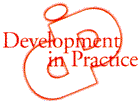
 |
Editorial, volume 7, number 1
All development agencies aim to promote change, and most would claim to seek the kind of change that will expand the choices and opportunities enjoyed by all human beings. But there is sharp divergence among such agencies about which choices matter most (and to whom), and how to enable people to exercise them. Some believe that resources -- such as wealth, power, and knowledge -- will eventually benefit everyone: if the cake is bigger, runs the argument, then everyone will eventually get a slice. Others maintain that, without making the structures of power transparent and accountable, resources will always accrue to those who exert control over them, or can insist on claiming their entitlements: however big the cake is, if you cannot show that you have a right to a slice, you will receive none. In a globalising world whose immense resources are increasingly concentrated and whose richest and most powerful institutions are largely unaccountable, some suggest that debates over how to divide the cake are now beside the point: rather than investing in development alternatives, we should be visualising alternatives to development.1
All the same, real efforts have been made in recent years by scholars and practitioners of development -- often responding to the sustained critiques of radical activists such as the DAWN network2 -- to understand more about the complex nature of exclusion: who is invited to have a share of the cake, and who is not; how the guests are chosen; and through what mechanisms they reinforce their privileged access. These mechanisms range from the use of brute force to the less visible web of social relations and institutions (such as legal codes, belief systems, or political ideologies) that determine whose and which rights and freedoms are valued in practice. It is by examining the many factors and processes by which people's rights are denied them that we can learn how to promote change that is both desirable and sustainable for the majority -- but which does not depend on suppressing the rights and opportunities of others.3
The contributors to this issue of Development in Practice explore the relationships between exclusion and change from various perspectives. Miloon Kothari examines the struggle for the right to a place to live, both in terms of factors that promote exclusion and violence -- including the insecurity generated by the constant threat of eviction -- and how these constrain the possibility of sustaining change over time. The impact of chronic insecurity in 'a climate of terror' is the theme of the article by Martha Thompson (the first part of which was published in Volume 6 Number 4), in which reflects on the experience of working for a humanitarian agency during the Salvadoran civil war: a war which was itself a violent expression of how the powerful resisted any changes in the distribution of resources that they perceived as threats to themselves. Joseph E. Bock describes an example from India of how, given the right kinds of intervention, the energy of communal violence can be used as a force for constructive engagement. Gareth A. Jones looks at how various agencies define the phenomenon of street-children, a social group that epitomises exclusion and yet is often despised and feared by the rest of society. He gives an account of work being done in Mexico that tries to engage in a systematic and thoughtful way with such children and their families. David Tolfree reports on research into the varying needs of children during war and internal displacement, while Claire Fyvie and Alastair Ager look at the bleak future facing young people as they leave the State orphanages in Romania that attracted so much concern in 1989, but whose continued existence has since been largely forgotten.
Turning to the wider policy framework, Deborah Fahy Bryceson and John Howe show how certain World Bank and IMF policies are making it harder for small producers in Africa to survive. The combination of displacement, unemployment, and severe hardship affecting many African societies is a dangerous one. Sustained and deepening exclusion is not only unjust and unjustified; it is also unsustainable, and bears within it the seeds of violent conflict. This risk should be no more apparent than in Haiti, yet Kenneth A. Reinert and Jon E. Voss describe the failure of the major international lending institutions to engage with capable and articulate rural organisations in drawing up an economic development strategy for the country.
Finally, a number of shorter pieces explore the less tangible dimensions of exclusion. P. Boraian, N. Narayanasamy, and R. Ramesh report on the potentially devastating impact of a major reservoir project on very poor people who have neither the social confidence nor the organisational means to press their claims for decent compensation. Marion Meyer and Naresh Singh suggest that change, and resistance to it, are both rooted in material circumstances, and subjective. Indeed, Geoff Sands describes the difficulties of changing habits of thought and of professional practice, even following a civil war in which so many died in the struggle to transform their lives and their society.
Deborah Eade
Oxfam (UK and Ireland)
February 1996
Notes
1 See, for instance, 'Imagining a post-development era', by Arturo Escobar, in J. Crush (ed.) (1995), Power of Development, London: Routledge.
2 Development Alternatives with Women for a New Era, an influential network whose members include prominent feminist economists such as Peggy Antrobus and Devaki Jain.
3 The 1991 UN publication, The Realisation of the Right to Development states that '[a] development strategy that disregards or interferes with human rights is the very negation of development' -- a standard of which existing strategies fall far short.
![]()
|
|
Next Abstract |